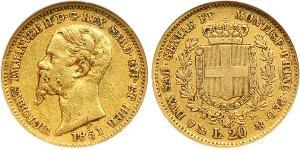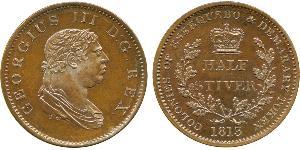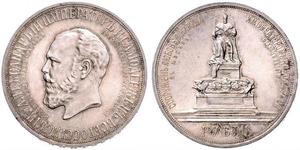(Venduta per $172.0)
1854, Saxony, Frederick Augustus II. Scarce Silver Mourning / Death Thaler Coin. R!
Mint Year: 1854 Mintage: 16,000. Reference: KM-1180.1. R! Denomination: Mourning Thaler ("Sterbetaler") Condition: Scattered contact-marks, otherwise a nice AU+ Mint Place: Dresden Mint. Material: Silver (.900) Weight: 22.16gm Diameter: 34mm
Obverse: Bare head of Frederick August II of Saxony right. Legend: FRIEDDRICH AUGUST II. * KOENIG VON SACHSEN + D.9. AUG. 1854 Reverse: Seated togate female allegoric figures (Justitia & Saxonia). Upside-down torches behind shield of Saxony above Legend: ER SAEETE GERECHTIGKEIT UND ERNTETE LIEBE. HOSEA X. 12. Traslated: "He sow justice and harvested love"
Frederick Augustus II (full name: Frederick Augustus Albert Maria Clemens Joseph Vincenz Aloys Nepomuk Johann Baptista Nikolaus Raphael Peter Xavier Franz de Paula Venantius Felix) (German: Friedrich August II.; b. Dresden, 18 May 1797 – d. Brennbüchel, in Karrösten, Tyrol, 9 August 1854) was King of Saxony and a member of the House of Wettin.
He was the eldest son of Maximilian, Prince of Saxony --younger son of the Elector Frederick Christian of Saxony—by his first wife, Caroline of Bourbon, Princess of Parma.
From his birth, it was clear that one day Frederick Augustus would become King of Saxony. His father was the only son of the Elector Frederick Christian of Saxony who left surviving male issue. When the King Frederick Augustus I died (1827) and Anton succeeded him as King, Frederick Augustus became second in line to the throne, preceded only by his father Maximilian.
He was an officer in the Wars of Liberation. However, he had hardly interest in military affairs.
The July Revolution of 1830 in France marked the beginning of disturbances in Saxony that autumn. The people claimed a change in the constitution and demanded a young regent of the kingdom to share the government with the King Anton. On 1 September the Prince Maximilian renounced his rights of succession in favor of his son Frederick Augustus, who was proclaimed Prince Co-Regent (de: Prinz-Mitregenten) of Saxony. On 2 February 1832 Frederick Augustus brought Free Autonomy to the cities. Also, by an edict of 17 March of that year, the farmers were freed from the corvée and hereditary submission.
On 6 June 1836 the King Anton died and Frederick Augustus succeeded him as King. As an intelligent man, he was quickly popular with the people as he had been since the time of his regency. The new king solved political questions only from a pure sense of duty. Mostly he preferred to leave these things on the hands of his ministers.
A standardized jurisdiction for Saxony created the Criminal Code of 1836. During the Revolutionary disturbances of 1848 (March Revolution), he appointed liberal ministers in the government, lifted censorship, and remitted a liberal electoral law. Later his attitude changed. On 28 April Frederick August II dissolved the Parliament. In 1849, Frederick Augustus was forced to flee to the Königstein Fortress. The May Uprising was crushed by Saxon and Prussian troops and Frederick was able to return after only a few days.
During a journey in Tyrol, he had an accident in Brennbüchel in which he fell from in front of a horse that stepped on his head. On 8 August 1854, he died in the Gasthof Neuner. He was buried on the 16 August in the Katholische Hofkirche of Dresden. In his memory, the Dowager Queen Maria arranged to establish a King's chapel at the accident place, which was consecrated one year later.
In Vienna on 26 September 1819 (by proxy) and again in Dresden on 7 October 1819 (in person), Frederick Augustus married firstly with the Archduchess Maria Caroline of Austria (Maria Karoline Ferdinande Theresia Josephine Demetria), daughter of Emperor Francis I of Austria. They had no children.
In Dresden on 24 April 1833 Frederick Augustus married secondly with the Princess Maria of Bavaria (Maria Anna Leopoldine Elisabeth Wilhelmine), daughter of the King Maximilian I of Bavaria. Like his first marriage, this was childless.
Without issue, after his death Frederick Augustus was succeeded by his younger brother, Johann.
Only 1$ shipping for each additional coin purchased!

1 Thaler Regno di Sassonia (1806 - 1918) ...
il gruppo ha 13 monete / 13 prezzi
Add coin to this group

1 Thaler Meclemburgo-Schwerin (1352-1918 ...
il gruppo ha 19 monete / 19 prezzi
Add coin to this group

20 Lira Kingdom of Italy (1861-1946) Oro ...
il gruppo ha 16 monete / 15 prezzi
Add coin to this group

1/4 Gulden Regno dei Paesi Bassi (1815 - ...
il gruppo ha 12 monete / 12 prezzi
Add coin to this group

2 Krone Danimarca Argento Cristiano IX d ...
il gruppo ha 13 monete / 12 prezzi
Add coin to this group

1/2 Stiver Regno Unito di Gran Bretagna ...
il gruppo ha 14 monete / 13 prezzi
Add coin to this group
1 Rublo Impero russo (1720-1917) Argento
il gruppo ha 12 monete / 12 prezzi
⇑
40 coin descriptions were improved from 2025-05-21 to 2025-05-28
Una di queste è:
5 Yuan Cina Argento
il gruppo ha 2 monete










-300-150-72sKbzbis7EAAAFPBUQ1Mk0C.jpg)







